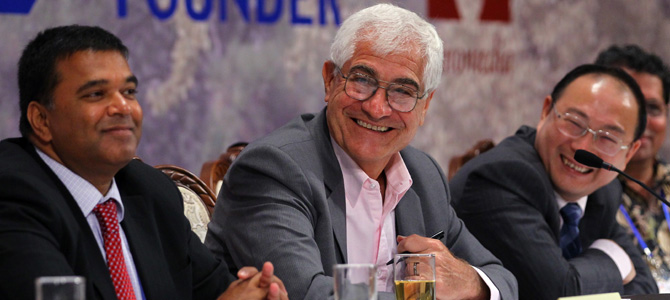
Mark Prisk, who was then minister for business and enterprise, said at the exhibition that his team had led an increasing number of trade missions to emerging markets such as China for technology businesses in recent years.
"Historically we've tended to look more towards markets close to us, but one thing we've tried to do over the last few years is to reach beyond the immediate markets to look at South America, China, India and elsewhere."
The exhibition, entitled UK Manufacturing: a Global Success Story, included world famous British companies such as Rolls-Royce and Jaguar Land Rover, which have significant exports to China.
China overtook the US last year to become the largest market for Rolls-Royce, and during the year the company sold 3,538 cars, a record in its 107-year history. Jaguar Land Rover also enjoyed record sales last year, with 76 percent sales growth in China.
Prisk said the second reason for staging the exhibition was to encourage Britain's young people into highly skilled engineering jobs, London's financial-services industry having lured away the nation's best talent with big bonuses for decades.
"A very small number of people in the financial services industry get very well paid, but actually most of the people in retail banking are no better paid than skilled engineers," Prisk said.
The exhibition attracted more than 4,000 visitors in the first few days, he said, including many British families, which he said was a sign that the country's young people and their parents are beginning to see engineering as a career option.
In addition, the British government is investing 1.5 billion pounds in the financial year 2012-13 to support 700,000 apprentices in training.
"We are strengthening the curriculum for young people coming out of schools into training, because we actually have some great companies here and they need more people," Prisk said.
To better commercialize output in university laboratories, the British government launched a network of what it calls catapult centers to conduct research and development in key areas, including high-value manufacturing.
The first such center opened last October, and six more are expected to be fully operational next year.
"We have a very strong academic community, but in the past we've not had a great success in taking the bright ideas and getting them into the market space," Prisk said. "And that's really why we've looked at investing in our catapult centers."
Meanwhile, China's demand for technology and know-how to facilitate a shift from high growth to sustainability is creating good opportunities for British businesses with advanced technologies.
One business that has succeeded in capturing this opportunity is Romax Technology, a British engineering company specializing in simulation technology and wind energy.
"Because the Chinese government is encouraging renewable energy, some Chinese companies came to us directly in 2007 and 2008 asking if we could help them develop wind turbines," said Carlo Bianco, sales operations manager of Romax's wind division.
On the renewable energy front, China's 12th Five-Year Plan (2011-15) set a goal of cutting the amount of energy and carbon dioxide emissions needed for every unit of economic output by 16 and 17 percent per unit of GDP respectively, thus creating financial incentives for companies to develop non-fossil fuel energy.
Having only entered the Chinese market in 2007, Romax's China operations now include 30 engineers in four representative offices, generating sales in excess of 3 million pounds a year.
In 2009 Romax helped Dalian Huarui Heavy Industry International to make a 3 megawatt wind turbine gearbox, which was used in the Sinovel 3 mW turbine in China's first offshore wind farm off the coast of Shanghai.
Bianco said the technology Romax sells to its Chinese customers is sufficient to produce wind turbines of a global standard. "They would be able to export to Europe as original equipment manufacturers if they want to," he said.
Romax is also helping with knowledge transfer for wind technology by training its customers' employees, sometimes for months at its headquarters in Britain.
Despite the success that companies like Bulwell, Satra and Romax have achieved in China, Britain's advanced manufacturing and engineering exports to China still lag behind some other European countries, notably Germany.
Last year trade between China and Britain totaled $58.7 billion; the equivalent figure for Germany was $190 billion.
Prisk acknowledged this gap.
"I think where Germany got it right in the past was encouraging the engineers to have a high professional status. Now we want to do it here."
The British government has also launched The Queen Elizabeth Prize for Engineering, a 1 million pound award for groundbreaking innovation, which Prisk said is a key step towards this goal.
"Obviously we want to do more, and we are catching up with countries like Germany, but nevertheless I think that's good success."
cecily.liu@chinadaily.com.cn
 Washington to remain focused on Asia-Pacific
Washington to remain focused on Asia-Pacific RQFII target blue chips amid bear market
RQFII target blue chips amid bear market Australian recall for top two exporters
Australian recall for top two exporters China fears new car restrictions
China fears new car restrictions